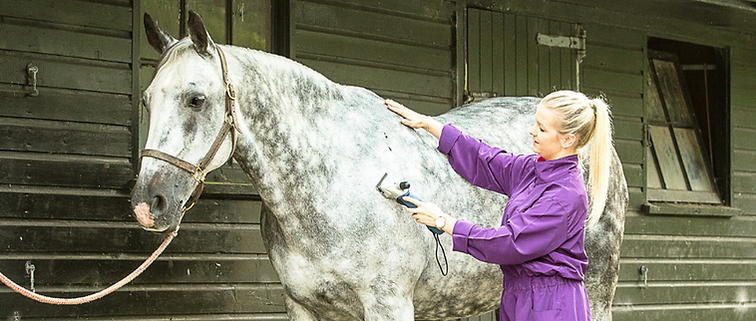The Ultimate Clipping Checklist for Horse Clipping
.png)
What you need to clip a horse
Whether you're preparing for a busy day in the salon or heading to the yard for a winter clip, having the right tools on hand is essential. This ultimate clipping checklist covers everything professional groomers, students, and horse owners need to work efficiently, safely, and with confidence. From the hair-resistant Clipit Suit and cordless clippers to blade care essentials and dog grooming starter kits, we’ve got you covered. Whether you’re clipping dogs, horses, or both, this guide ensures nothing gets left behind.
-
Extension Lead
-
Plaiting bands

The Hazards of Clipping Horses
It doesn't mater if you are a seasonal professional horse clipper or you have a horse of your own, clipping horses comes with risks and hazards.
Recently professional horse clipper Bekki Schofield took a nasty bite from a horse that she hadn't done before. Even though this horse hadn't done anything like this before, the owner was mortified to see her horse had taken a chunk out of the side of Bekki.
So what do you do to help prevent hazards when clipping?
Prepare a Safe Clipping Area
-
If it is the horse's first time, it is safer to have someone hold them rather than tied up.
-
Pick a time to clip when you have at least two to three hours available.
-
Make sure your area is free from clutter and large enough to allow you to move around the horse easily.
-
Have a place to lay out your equipment so it's out of reach of the horse but in an efficient place for you.
-
Ensure your extension lead is long enough to get around the horse without having to get over, under, or through the body and legs. There should always be enough slack that the wire can lie out of reach.
-
Always remember to plug your clipper or extension lead into a plug breaker, just in case the horse decides to step on the mains electric cable.
Getting Started
-
Make sure your clipper blades are on straight and tensioned correctly to ensure you don't get lines. Read here to discover How to Prevent Clipper Lines
-
Using clipper oil, make sure your clipper blades are well oiled before starting. Click this article on How to Look after you Clipper and Blades
-
Always use even pressure, moving the clippers against the natural growth of the hair. Sensitive and nervous horses can show signs of distress, and with uneven pressure can get upset, so take it easy.
-
Your first strokes should be on the a big muscle, such as the shoulder. The horse's ticklish areas include; behind the elbow, belly, stifle and sheath. Leave these areas until the horse is quiet and relaxed.
-
Things to Remember
-
Check your clipper blades frequently for heat. Hot blades can easily burn you and your horse. To cool them, use a coolant spray, such as Clipit Ice Care This product not only cools, but also helps to clean the blades. You may need to turn your clippers off for a while, until they cool down
-
Brush excess hair away from your clipper frequently and use clipper oil.
-
Take care around the elbow and stifle. The skin can easily be cut here if you dig your clipper blades in too deep.
-
On the chest area, use one hand to stretch the skin out flat to prevent lines.
-
Be aware of your horse's behaviour. Some will let you know that they are loosing patience. If your horse is unhappy being clipped in a certain area, leave it, go onto another area and then come back at a later time.
To summarise, you should ask yourself these questions before clipping a horse
-
Has this horse been clipped before?
-
Has this horse been clipped by another clipper before?
-
What is the weather conditions like?
-
Do you have enough light and space to clip?
-
Do you know how to properly tension your clipper?
-
Do you have enough clipper oil to get you through the clip?
-
Do you have enough time to complete the clip?





